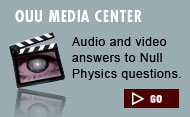Null Physics 101 | Technical Frequently Asked Questions
- Does null physics claim that quantum mechanics (QM) and general relativity (GR) are incorrect?
- Null physics claims that the most fundamental units of energy are second-meter^2. Isn't this in direct conflict with basic physics, which has energy's units as kilogram-meter^2/second^2?
- The chapter 2 excerpt has 1^M = (1^M/inf^3)(inf^3). Since 1^M = 1, this just reduces to 1 = 1, which isn't exactly a revelation. What kind of 'new physics' is this?
- I heard that null physics supports tired light as an explanation for the intergalactic redshift. Is this true?
- If photons lose energy in intergalactic redshift, where does this energy go?
- The Chapter 10 excerpt says that an atomic nucleus is composed of electrons and protons. Since electrons, protons and neutrons are all spin 1/2 fermions, doesn't this violate the conservation of angular momentum?
Does null physics claim that quantum mechanics (QM) and general relativity (GR) are incorrect?
Not at all. In fact, this rumor is a self-contradictory statement. QM and GR cover a lot of theoretical ground and both contain quite a few different premises. They are not binary values that are true or false. What null physics claims is that all of the phenomena described by QM and GR are the product of a single deep geometry. Null geometry is nonlinear and four-dimensional, as opposed to the 10 or more dimensions advocated by string theories. Null physics requires less dimensions because it isn't built on top of QM or GR; it forms their basis. (top)
Null physics claims that the most fundamental units of energy are second-meter^2. Isn't this in direct conflict with basic physics, which has energy's units as kilogram-meter^2/second^2?
No, it's actually a unification of basic physics. The SI system of measurement contains a number of 'fundamental' units, such as second, meter, kilogram, and Coulomb, many of which have been used, in one form or another, for hundreds of years. Theoretical physicists talk about grand unification all the time, but fail to realize that a truly unified theory will actually reduce the number of independent units that are used to describe the physical world. Null physics demonstrates a geometric relationship between the SI units of second, meter, and kilogram. (top)
The chapter 2 excerpt has 1^M = (1^M/inf^3)(inf^3). Since 1^M = 1, this just reduces to 1 = 1, which isn't exactly a revelation. What kind of 'new physics' is this?
The closure equation in the chapter 2 excerpt is not an algebraic equation in need of a solution. It describes the geometric relationship between space, infinite smallness, and totality. Just as a unit hypercube is not the same thing as a unit line segment, 1^4 and 1 are not the same thing (in a geometric context, at least). (top)
I heard that null physics supports tired light as an explanation for the intergalactic redshift. Is this true?
Tired light, which trys to explain the intergalactic redshift purely in terms of the energy loss of individual photons, fails a number of observational tests. The most important of these is the broadened light curves of Type 1a supernovae. The intensity of the light from these explosions has a characteristic rise time and decay period, and it has been found that the greater a signal's redshift, the broader (longer) the light curve, in direct proportion. Thus not only are photons redshifted, but the distance between them is also expanding over time. Further, the observed intergalactic redshift has no associated refractive or directional dispersion, and energy loss is proportional to photon energy. This means that it is not caused by the interaction between photons and any known form of matter or energy. Null physics shows, using the general theory of relativity, that the observed intergalactic redshift is consistent with the static spatial curvature of a nonexpanding universe. (top)
If photons lose energy in intergalactic redshift, where does this energy go?
Since the universe is not expanding, the energy lost by photons through intergalactic redshift has to go somewhere. The universe's primary luminosity is the optical band (UV-red), and when these photons are redshifted they release microwaves directly into the cosmic microwave background (CMB). Although these microwaves are initially colinear with their source photons (in order to conserve energy and momentum) they are quickly (by astronomical standards, at least) scattered by the next link in what is referred to in Our Undiscovered Universe as the cosmic fusion cycle. The CMB's power spectrum is consistent with this scattering mechanism, but there is far more direct evidence of this process, and it is presented in detail in Part IV of Our Undiscovered Universe. (top)
The Chapter 10 excerpt says that an atomic nucleus is composed of electrons and protons. Since electrons, protons and neutrons are all spin 1/2 fermions, doesn't this violate the conservation of angular momentum?
Bound electrons, as found in neutrons and atomic nuclei, and free electrons, as found orbiting atoms, in plasma, etc, are radically different geometries. A bound electron has a core radius comparable to that of a proton (< 1 F), whereas a free electron has a core radius of 1738 F, about 3% of the radius of a hydrogen atom. The process of compressing a free electron to its bound state is accompanied by the absorption of an antineutrino. The reason neutron decay releases a neutrino, and not a photon, is specifically because of the huge geometrical difference between electrons in their bound and free states. Neutrinos provide spin conservation, irrespective of whether or not a neutron is a proton-electron.
Electrons' 1738 F free-space radius is a completely natural extension of null geometry, and is responsible for the phenomenon known as electron degeneracy pressure. Null geometry also provides the basis of the strength and range of the Strong force between protons, the inter-nucleon spacing of a deuteron, the source of the Weak and Coulomb forces, and a host of other "mysteries".
It is important to note that contemporary physics offers no cohesive explanation of what "spin" actually is, or why elementary particles should possess it. Certainly it is related to the conservation of angular momentum, but it is just a quantum parameter that has no physical representation. Electrons are typically thought of as point particles, yet they "spin" on their axis and have a finite mass, both of which are geometrically nonsensical for a particle that has no volume. Einstein lost the fight between geometry and probability a long time ago, for two reasons. Firstly, because the geometry he used was nonphysical (please see the white paper section on this website). Secondly, because gravitation is not the most important of the universal forces. Null physics resumes and wins the debate between geometry and probability, using a revolutionary new physical geometry derived directly from the relationship between existence and nonexistence. (top)


